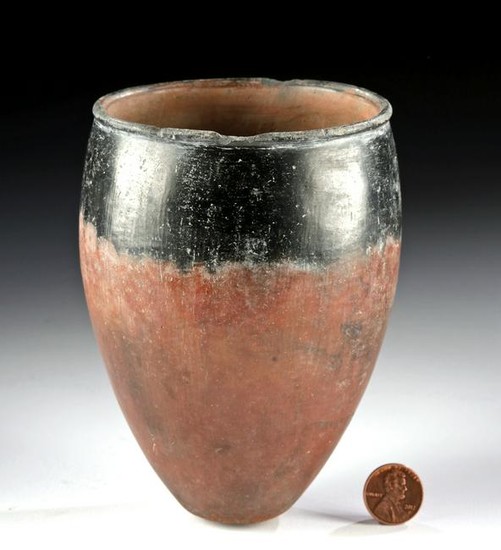Egyptian Predynastic Naqada I Blacktop Vase
Ancient Egypt, Pre-Dynastic period, late Naqada I to early Naqada II, ca. 3600 to 3300 BCE. A gorgeous coil-formed Nile silt pottery vessel with a highly burnished, russet-hued surface made with a thin iron-oxide slip. The vase has an ovoid body which rests gently upon a round yet stable foot, with a deep interior cavity and a rolled rim. The upper black-hued portion is comprised of thick carbon deposits formed by administering the top to thick clouds of smoke for extended periods of time in an oxygen-deprived environment. Black-top vessels originally rose to popularity during the early Naqada I, a culture which inhabited ancient Egypt during its pre-dynastic period. The Naqada were first described by famed archaeologist William Flinders Petrie, however relatively little is known about them except that they were focused around the site of El-Amra in central Egypt, west of the Nile River. Size: 3.375" W x 5" H (8.6 cm x 12.7 cm).
Pre-Dynastic Egyptian black-top vessels were traditionally made from silt deposits taken from the Nile river due to their abundance in iron and silica. After the pot had dried but before it was fired, it would first be burnished and rubbed smooth with a small stone to create the pinstripe vertical striations still visible today. An iron-rich slip would then be applied just before firing; when placed in an oxygen-rich environment, the elevated temperatures would create the vessels' signature red-orange hue.
After the end of the Naqada III period around 3,000 BCE, the use of Nile silt in pottery creations fell out of favor with the Pre-Dynastic Egyptians. This is due to the increase in popularity of marl clay, a newly discovered material for creating terracotta objects which was easier to shape and enabled firing at far greater temperatures than the highly porous silt.
For a stylistically similar example, please see The Metropolitan Museum of Art, accession number 36.1.4.
Provenance: private East Coast, USA collection; ex-Artemis Gallery; ex-private New Jersey, USA collection; ex-Norman Blankman collection, New York, USA, acquired in the 1950s
All items legal to buy/sell under U.S. Statute covering cultural patrimony Code 2600, CHAPTER 14, and are guaranteed to be as described or your money back.
A Certificate of Authenticity will accompany all winning bids.
We ship worldwide to most countries and handle all shipping in-house for your convenience.
#149844
Condition Report: Surface wear and abrasions commensurate with age, small nicks to rim and body, light roughness to base, with some minor discoloration, otherwise intact and near choice. Light earthen deposits and root marks. Nice craquelure to exterior slip. Old inventory label with "135" on shoulder. Old inventory numbers "NY. 1270 25094" written inside rim.
View it on
Estimate
Time, Location
Auction House
Ancient Egypt, Pre-Dynastic period, late Naqada I to early Naqada II, ca. 3600 to 3300 BCE. A gorgeous coil-formed Nile silt pottery vessel with a highly burnished, russet-hued surface made with a thin iron-oxide slip. The vase has an ovoid body which rests gently upon a round yet stable foot, with a deep interior cavity and a rolled rim. The upper black-hued portion is comprised of thick carbon deposits formed by administering the top to thick clouds of smoke for extended periods of time in an oxygen-deprived environment. Black-top vessels originally rose to popularity during the early Naqada I, a culture which inhabited ancient Egypt during its pre-dynastic period. The Naqada were first described by famed archaeologist William Flinders Petrie, however relatively little is known about them except that they were focused around the site of El-Amra in central Egypt, west of the Nile River. Size: 3.375" W x 5" H (8.6 cm x 12.7 cm).
Pre-Dynastic Egyptian black-top vessels were traditionally made from silt deposits taken from the Nile river due to their abundance in iron and silica. After the pot had dried but before it was fired, it would first be burnished and rubbed smooth with a small stone to create the pinstripe vertical striations still visible today. An iron-rich slip would then be applied just before firing; when placed in an oxygen-rich environment, the elevated temperatures would create the vessels' signature red-orange hue.
After the end of the Naqada III period around 3,000 BCE, the use of Nile silt in pottery creations fell out of favor with the Pre-Dynastic Egyptians. This is due to the increase in popularity of marl clay, a newly discovered material for creating terracotta objects which was easier to shape and enabled firing at far greater temperatures than the highly porous silt.
For a stylistically similar example, please see The Metropolitan Museum of Art, accession number 36.1.4.
Provenance: private East Coast, USA collection; ex-Artemis Gallery; ex-private New Jersey, USA collection; ex-Norman Blankman collection, New York, USA, acquired in the 1950s
All items legal to buy/sell under U.S. Statute covering cultural patrimony Code 2600, CHAPTER 14, and are guaranteed to be as described or your money back.
A Certificate of Authenticity will accompany all winning bids.
We ship worldwide to most countries and handle all shipping in-house for your convenience.
#149844
Condition Report: Surface wear and abrasions commensurate with age, small nicks to rim and body, light roughness to base, with some minor discoloration, otherwise intact and near choice. Light earthen deposits and root marks. Nice craquelure to exterior slip. Old inventory label with "135" on shoulder. Old inventory numbers "NY. 1270 25094" written inside rim.



